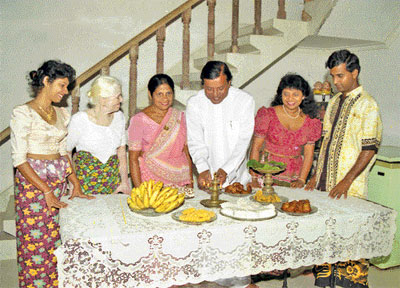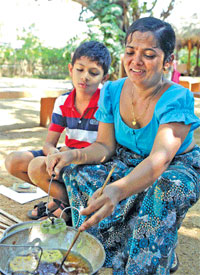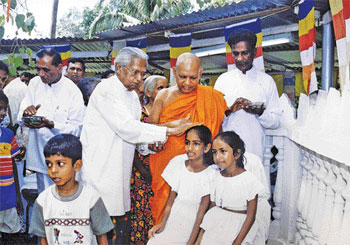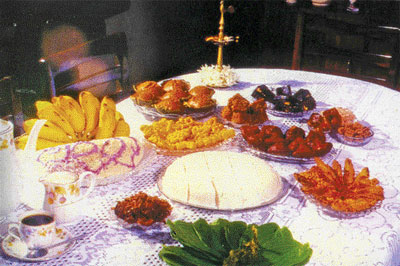|
Sinhala and Hindu News Year:
Traditional customs
With the month of April comes the sweet scent of erabudu blossoms and
the haunting melody of the koel reminding us that once again it is time
to celebrate the
 Sinhala
and Hindu New year. It is the time to bid farewell to the old year and
usher in the New Year. All the customs and rituals connected with this
traditional celebration are centred around auspicious times set by
astrologers. In the olden days, the astrologer of the village who is
known as the 'Nekath Raala' distributed a paper, which indicated the
relevant auspicious times. Sinhala
and Hindu New year. It is the time to bid farewell to the old year and
usher in the New Year. All the customs and rituals connected with this
traditional celebration are centred around auspicious times set by
astrologers. In the olden days, the astrologer of the village who is
known as the 'Nekath Raala' distributed a paper, which indicated the
relevant auspicious times.
This was popularly known as the 'Avurudu Seettuwa'. During the early
days, these Nekath or auspicious times changed according to the area and
the families of astrologers. It was only after 1970 that everyone agreed
upon a common set of auspicious times for the avurudu rituals, explained
the former Dean of the Faculty of Arts, University of Sri
Jayewardenepura, Professor Tissa Kariyawasam.
The New Year is a family celebration tied with traditions of visiting
parents, making peace and starting everything anew. During this time,
town dwellers who have their roots in the village take time off to visit
their parents and relatives. Before the New Year, they pay off all loans
as it was the time to heal, and make amends. This practice was known as
the davurudu kireema.
Nonagathaya or the
Punya kaalaya
"It is a misconception that there are no nekath during the
nonagathaya period," says Prof. Kariyawasam. "There are auspicious times
(nekath) around the clock; they can be good or bad. Good nekath will
give us good results and bad ones will give negative results
accordingly," he added. "This period is a transitional period between
the old and the New Year. People refrain from doing anything until the
Sun moves to a new astrological position. Therefore, before the
nonagathe period, people clean the fireplaces, remove the ash, clean the
kitchen; buy new pots and pans, eat the last meal of the old year and
get ready to welcome the New Year. They use this time to engage in
religious activities hoping to receive blessings for the New Year. Many
of us visit the temple with flowers, joss sticks, oil, and wicks, don't
we? Hindus also visit the Kovil during this period. This is considered
as a neutral period or rather a relaxing period before the dawn of New
Year.
Sighting of the new
moon
 This
is the first New Year ritual we have in the Almanac (Panchanga litha).
There are two auspicious times to see the moon; one is for the Old Year
and another for the New Solar Year. Once you see the moon for the old
year, it is advised to refrain from looking at it until the New Year. This
is the first New Year ritual we have in the Almanac (Panchanga litha).
There are two auspicious times to see the moon; one is for the Old Year
and another for the New Solar Year. Once you see the moon for the old
year, it is advised to refrain from looking at it until the New Year.
Our ancestors believed that the sighting of the new moon is a good
omen. "This ritual is mentioned in one of the graffiti's on the Sigiriya
Mirror wall as well," said Prof. Kariyawasam. According to him, there
the moon is referred as nava bhaga sanda (new lucky moon).
The graffiti writer had asked those women on the frescos, why they
would not talk to him despite him being a person who sighted the new
moon.
Lighting the hearth
When the sound of firecrackers fills the air we know that the New
Year has dawned. The auspicious time to light the hearth is usually set
soon after the dawn of the New Year. Many make a new hearth to carry out
this ritual.The chief female occupant of the house worships the pot
thrice before lighting the hearth. Then she boils the milk and prepares
milk rice (kiribath). However, in some households, the ritual of boiling
a pot of milk is not practised. For this ritual the members of the
family dress in the auspicious colour or colours, which are also
prescribed according to the day the New Year falls on.

The days are governed by planets. According to astrology these
planets have their favourite colours and trees, explained Prof.
Kariyawasam. "As an example, Tuesday is the day of planet Mars and its
colour is red," he added.
The next ritual is one of the favourite among children - commencement
of work, first transaction and consumption of the first meal. Sinhalese
families eat kiribath with sweetmeats and other accompaniments while
Hindu's eat sweet rice called Sakkara Pongal during the auspicious time.
Then comes the time for the ritual of the first transaction. In the
olden days, the first transaction was done with the well. The chief
female occupant of the house dropped a coin wrapped in a piece of clean
cloth into the well and filled a bottle from the first bucket drawn from
the well.
Then this bottle was kept in the house and the level of water in the
bottle was monitored throughout the year. It was believed the level of
water indicates the prosperity of the house. "If the water level has
gone down, it was believed to be a sign of a bad period the family
suffered," said Prof. Kariyawasam.
"During the first few months after the dawn of the New Year,
housewives checked this bottle from time to time to get an idea about
the good and the bad periods of their family. It gave them some kind of
a satisfaction," he added. As a part of this ritual, the younger people
worship the elders with a sheaf of beetle leaves and then the elders
give them some money.
At this time, they are given a coin to offer to god and some money
for their use, Hindu's call this ritual Kai Vishesham,which is
exchanging money between the family members.
The head of the family will start this custom by exchanging money and
blessing them with good luck.
The next part of the ritual is commencement of work. In some areas,
elders who are involved in agriculture would use their equipment in a
symbolic manner. They would chop a branch or make a cut on a jak tree
with the knife usually used by an elder and cut a sod of soil. It was
customary to plant a sapling. During this nekatha, children in the house
are encouraged to study, with the intention of having a good year for
studies. Some families invite someone successful and of some standing in
society for the first meal of the year. They believed that doing the
first transaction with a person of that calibre would bring them good
luck. After completing these rituals, nowadays people exchange plates of
sweetmeats among the neighbours.
 "This
is not a customary ritual practised during the olden days. Why should we
give sweetmeats that they have already made?" he questioned. However,
sweetmeats and bananas are taken when visiting friends and relatives
during the season. "This
is not a customary ritual practised during the olden days. Why should we
give sweetmeats that they have already made?" he questioned. However,
sweetmeats and bananas are taken when visiting friends and relatives
during the season.
Anointing oil

In ancient times, the oil anointing ceremony was held at temples and
the chief incumbent of the temple applied coconut oil mixed with special
liquid called Naanu and some medicinal herbs on the villagers' heads.
These days, mostly an elder of the family anoints oil at the
auspicious time. They use herbal leaves to stand on and to anoint oil on
head. Leaves such as margosa, banyan and kolon are used.
The oil anointing ceremony is usually held towards the latter part of
the New Year celebration. The type of leaves are prescribed according to
the day. It is usually the favourite tree of the planet of the day.
Leaving home for work
This is a ritual of the modern day, said Prof. Kariyawasam. During
the good old days what we had was an agricultural society. Those farmers
started their work just after partaking the first meal.
This was included in the recent past when people started working at
offices, he added. Usually there is a colour to wear and a direction to
look at when leaving home for work.
- Janani AMARASEKERA |

